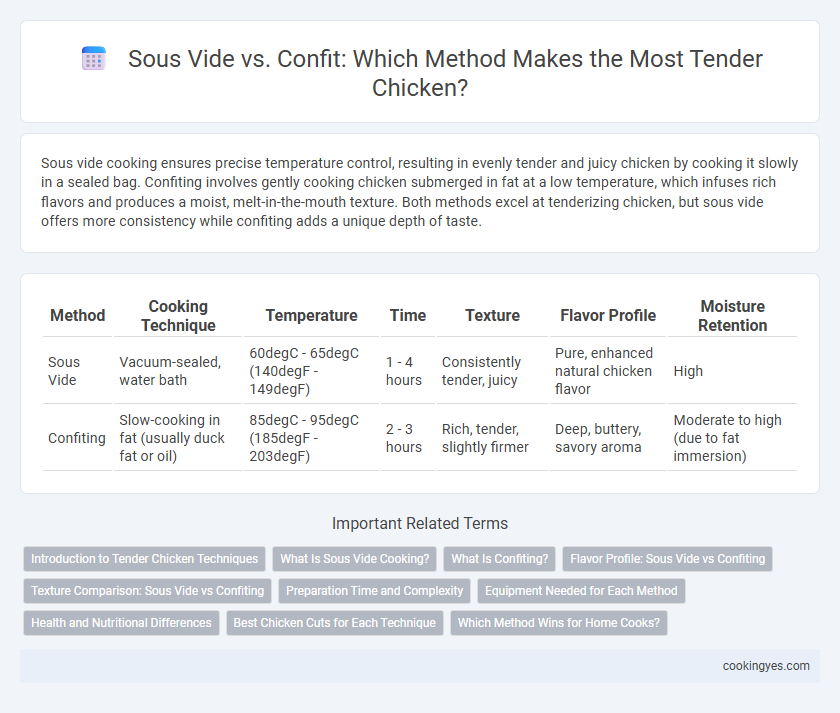Sous vide cooking ensures precise temperature control, resulting in evenly tender and juicy chicken by cooking it slowly in a sealed bag. Confiting involves gently cooking chicken submerged in fat at a low temperature, which infuses rich flavors and produces a moist, melt-in-the-mouth texture. Both methods excel at tenderizing chicken, but sous vide offers more consistency while confiting adds a unique depth of taste.
Table of Comparison
| Method | Cooking Technique | Temperature | Time | Texture | Flavor Profile | Moisture Retention |
|---|---|---|---|---|---|---|
| Sous Vide | Vacuum-sealed, water bath | 60degC - 65degC (140degF - 149degF) | 1 - 4 hours | Consistently tender, juicy | Pure, enhanced natural chicken flavor | High |
| Confiting | Slow-cooking in fat (usually duck fat or oil) | 85degC - 95degC (185degF - 203degF) | 2 - 3 hours | Rich, tender, slightly firmer | Deep, buttery, savory aroma | Moderate to high (due to fat immersion) |
Introduction to Tender Chicken Techniques
Sous vide and confiting are two precise cooking techniques that guarantee tender chicken by maintaining consistent low temperatures and preserving moisture. Sous vide uses vacuum-sealed bags submerged in a temperature-controlled water bath, ensuring even cooking and enhanced flavor retention. Confiting involves slow-cooking chicken submerged in fat, which tenderizes the meat while infusing it with rich, succulent flavors.
What Is Sous Vide Cooking?
Sous vide cooking involves vacuum-sealing chicken and slowly cooking it in a precisely temperature-controlled water bath, ensuring even doneness and retaining moisture. This method allows for consistent tenderness by gently breaking down proteins without overcooking, resulting in juicy, flavorful chicken. Compared to confiting, which cooks chicken slowly in fat at low temperatures, sous vide offers exact temperature control and a cleaner, less oily finish.
What Is Confiting?
Confiting is a traditional cooking method where chicken is slowly cooked in its own fat or oil at a low temperature, resulting in exceptionally tender and flavorful meat. The gentle heat preserves moisture and allows the chicken to absorb rich flavors while maintaining a delicate texture. This technique differs from sous vide by immersing the chicken in hot fat rather than vacuum-sealing it in a water bath, creating a uniquely succulent and tender outcome.
Flavor Profile: Sous Vide vs Confiting
Sous vide chicken offers a clean, precise flavor with enhanced moisture retention thanks to its controlled low-temperature cooking, which preserves the natural juices and subtle spices. Confiting imparts a richer, more intense flavor by slowly cooking the chicken in fat, resulting in a tender texture with a pronounced savory and slightly caramelized taste. Both methods deliver tender chicken, but sous vide emphasizes purity of flavor while confiting enhances depth and richness.
Texture Comparison: Sous Vide vs Confiting
Sous vide cooking delivers consistently tender chicken by maintaining precise low temperatures, resulting in juicy meat with a uniform texture throughout. Confiting, which involves slow-cooking in fat, produces a rich, silky texture with a slightly crisp exterior due to fat immersion. While sous vide emphasizes moisture retention and delicate softness, confiting enhances flavor depth and imparts a uniquely velvety mouthfeel.
Preparation Time and Complexity
Sous vide chicken requires precise temperature control and longer cooking times, often between 1 to 4 hours, to achieve tender, evenly cooked meat, making it ideal for maintaining juiciness with minimal moisture loss. Confiting chicken involves slow-cooking submerged in fat at lower temperatures, typically taking 2 to 3 hours, resulting in exceptionally tender texture but demands careful fat management and attention to prevent overcooking. Both methods offer tender chicken, with sous vide providing consistent results through technology, while confiting emphasizes traditional, fat-based slow cooking with moderate preparation complexity.
Equipment Needed for Each Method
Sous vide cooking for tender chicken requires a precision immersion circulator and a vacuum sealer to maintain consistent water temperature and airtight sealing during the cooking process. Confiting chicken involves submerging the meat in rendered fat, necessitating a heavy-bottomed pot or enameled cast iron Dutch oven along with a reliable heat source for low-temperature cooking. While sous vide offers precise temperature control through advanced equipment, confit relies on traditional cookware and fat, making the equipment needed for each method distinct and specialized.
Health and Nutritional Differences
Sous vide cooking preserves chicken's natural nutrients by cooking it at precise, low temperatures, minimizing nutrient loss and maintaining moisture without added fats. Confiting involves slow-cooking chicken in submerging fat, increasing calorie and saturated fat intake while enhancing tenderness and flavor. Healthwise, sous vide is a leaner option promoting nutrient retention, whereas confiting adds richness but also higher fat content.
Best Chicken Cuts for Each Technique
Chicken breast is ideal for sous vide cooking due to its lean texture, allowing precise temperature control to achieve tender, juicy results. Chicken thighs, rich in fat and connective tissue, respond best to confiting, where slow cooking in fat breaks down tough fibers for succulent, flavorful meat. Wing and drumstick cuts also benefit from confiting, as the low-and-slow method enhances tenderness while preserving moisture.
Which Method Wins for Home Cooks?
Sous vide cooking ensures precise temperature control, yielding consistently tender and juicy chicken by sealing in moisture during slow, even cooking. Confiting chicken in its own fat develops rich flavors and a silky texture but requires more fat and longer cooking times. For home cooks seeking ease, reliability, and optimal tenderness, sous vide edges out confiting as the preferred method for perfectly cooked chicken breasts and thighs.
Sous vide vs Confiting for tender chicken Infographic

 cookingyes.com
cookingyes.com